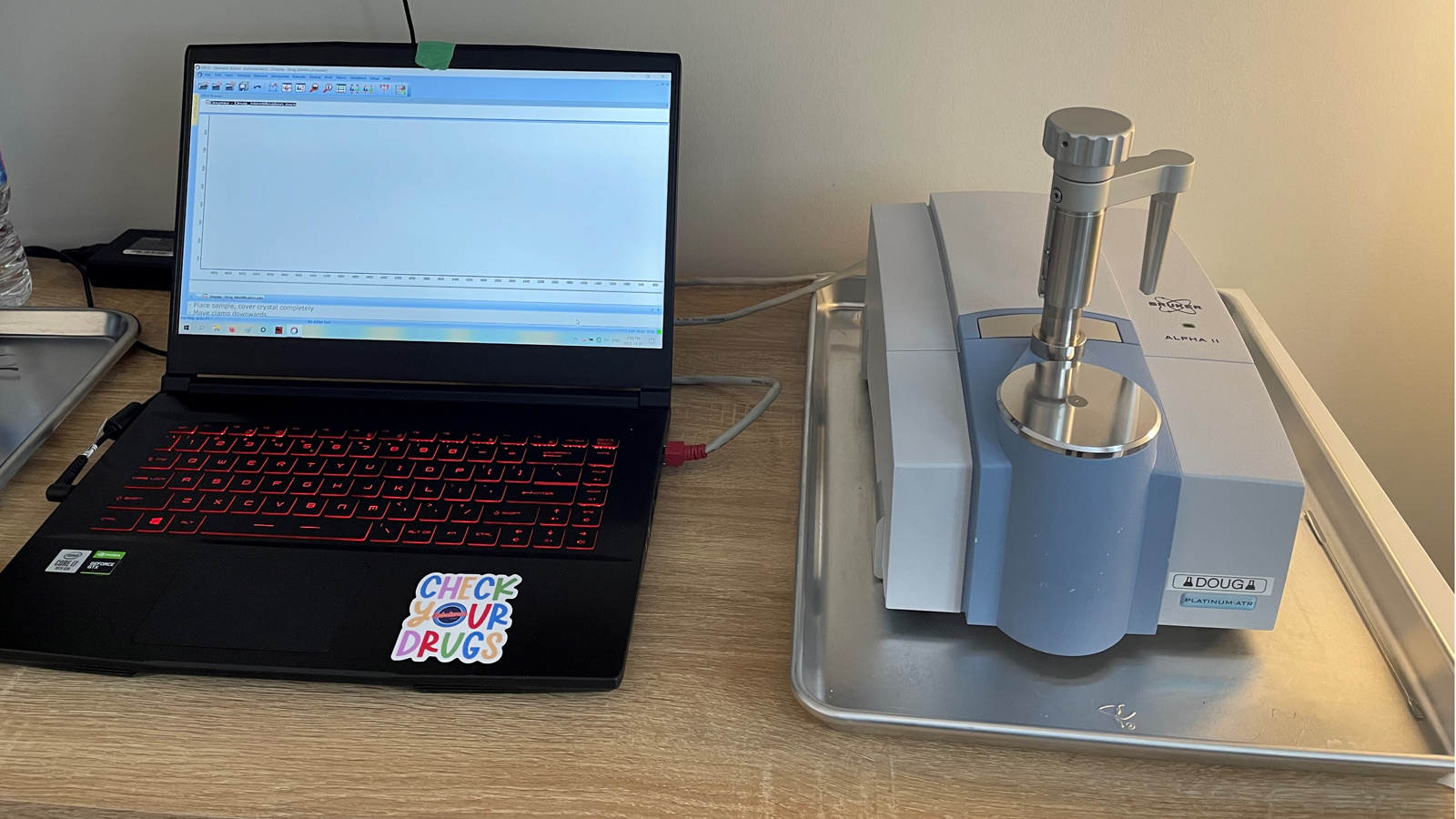Drug checking services are offered within the supervised consumption site (SCS) at Blood Ties Four Directions Centre (Blood Ties). Drug checking services allow clients of the SCS, as well as the broader community, to have their drugs checked during regular SCS hours (Monday to Friday 12:00 p.m. to 9:00 p.m.). Drug checking is done using a Fourier transform infrared (FT-IR) spectrometer as well as strip testing for fentanyl and benzodiazepines.
How does drug checking work?
Two approaches to drug checking are used at the SCS:
- A Fourier transform infrared (FT-IR) spectrometer, which is a machine used for chemical analysis, can detect up to six components of a sample, including any cuts or buffs.* Examples include fentanyl, benzodiazepines, heroin, cocaine, methamphetamines and cutting agents.
- Immunoassay testing strips (test strips) are used to test samples for fentanyl and benzodiazepines.
The FT-IR spectrometer uses light absorption to determine the composition of a substance, including any cuts or buffs in the sample. The FT-IR spectrometer has a 5% detection limit, which means that it cannot reliably detect substances that are less than 5% of the total sample. Testing strips are used in conjunction with FT-IR spectroscopy as they are more sensitive than FT-IR and can detect fentanyl and benzodiazepines at lower concentrations.
Technicians require extensive training to conduct FT-IR spectroscopy. Blood Ties currently employs five technicians who have completed the necessary training. Additional staff have attended preliminary trainings. All SCS staff are trained in strip testing.
Drug checking in the SCS
When a client enters the SCS, they check in at the reception desk and indicate that they would like their drugs tested. The client is then brought to the private drug checking room. The technician and client discuss how the drugs will be tested, as well as the limitations of the tests. The best practice approach in the SCS is to test all samples using the FT-IR spectrometer and test strips, as this will yield the most detailed and accurate results for clients.
Ideally two staff members are present in the room when drug checking occurs and clients are offered a comfortable chair to sit in to wait for the results.
The process of discussing drug checking with clients and completing the actual test takes approximately 10–15 minutes. During this time, the technician discusses harm reduction approaches to using substances, such as not using alone and carrying naloxone, and can answer any questions that clients may have.
Take-home drug checking
Clients can also obtain fentanyl testing strips to take home either through the SCS or the needle and pipe program co-located in the same building. Staff provide clients with a brief training on how to use the testing strips. Benzodiazepine testing strips are not available to take home, as they have additional limitations and are not as straightforward to use.
Other drug checking services
Blood Ties started offering drug checking services in 2018. A number of approaches are used outside of the SCS, including:
- fentanyl test strip and FT-IR spectrometer testing through the needle and pipe program (located in the same building as the SCS)
- fentanyl and benzodiazepine strip and FT-IR spectrometer testing at music festivals
- fentanyl and benzodiazepine strip testing through Blood Ties’ mobile harm reduction outreach van seven days per week
- weekly pop-up fentanyl and benzodiazepine strip testing at the Housing First building and Kwanlin Dün Health Centre
Who is using the drug checking services and why?
The majority of the people using the drug checking service at the SCS are clients who plan to use their drugs at the SCS, although individuals from the broader community also use the service. People who sell drugs also sometimes use the drug checking services to provide people who are purchasing drugs with more information about the substances in the drugs being bought.
Over 300 samples were tested across all sites between 2018 and 2022 and uptake has increased significantly since FT-IR drug checking services were implemented in the summer of 2021. There has not been a widespread promotional campaign for the drug checking services but there may be one in the future, which may further increase the reach of the program.
*Cuts and buffs are normally less expensive substances and/or fillers that are added to a substance to increase the amount of drug without significantly altering its effects. They may or may not have mild psychoactive properties (e.g., caffeine or sugars).

